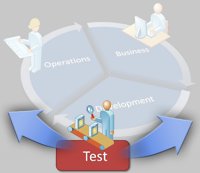Generalist Testers (Manual Testers) do like on-the-fly testing! It feels good to be creative and impulsive!! Let's react on the behavior of the system!........... Maybe it's not as efficient and/or effective as structured testing, but it is fun!
Too much fun brings also disadvantages. In complex systems, with many dependencies under the surface, on-the-fly testers aren't able (most of the time), to write reproducible bug reports. And that's a nightmare for the project manager. Non reproducible bugs are time consuming and expensive, so "on-the-fly testing" is banned out of the life of the Generalist Testers and replaced by structured test methods.
"Reproducibility refers to the ability of a test to be accurately reproduced,
or replicated, by someone else working independently" - Wikipedia

On-the-fly Testing...
Nowadays testers must work in formal structures, of course for efficient testing, but especially for generating reproducible bug reports. Writing an accurate bug report is NOT easy. It takes relatively much time, and even then they are not accurate enough, so developers may call for more information, or even worse, they close the bug report with the state "non reproducible". And believe me...That's not funny at all!
The new test suite of Microsoft (codename Camano) is in my opinion a great chance for improvement. Instead of converting Generalist Testers into technical skilled testers, Microsoft has chosen to support the way Generalist Testers like to work: "Manual Testing"!
Generalist Testers must write accurate bug reports, but now they can stop detailed manual logging of their actions. Because the bug reporting of Camano is great! Camano can keep track of the complete manual (structured or not) behavior of the Generalist Tester. So if a tester is a bit enthusiastic and performs more, better or other tests than originally planned, Camano don't mind, the Microsoft Test Runner records everything in the background for the later uses:
By combining Camano with the flexibility of our structured test approach TMap®, I can re-introduce on-the-fly testing in our test projects!
Also, with Camano it is possible to have the fun of on-the-fly testing and still report reproducible bug reports. Combining Camano with TMap® makes it possible for us to do result driven test assignments (agreements with the project management concerning time, budget and/or test coverage) and still enjoy testing.
To explain the test teams the balance between structured and on-the-fly testing and how to use Camano in the test project, I've written a fictitious case .
The case contains (a description of):
I'm sure the developers will like Camano. Especially if they find out that the bugs are reported accurately!
Because: Fast bug fixing is almost as good as making no bugs at all!

... what about "Non Reproducibility"?
Too much fun brings also disadvantages. In complex systems, with many dependencies under the surface, on-the-fly testers aren't able (most of the time), to write reproducible bug reports. And that's a nightmare for the project manager. Non reproducible bugs are time consuming and expensive, so "on-the-fly testing" is banned out of the life of the Generalist Testers and replaced by structured test methods.
or replicated, by someone else working independently" - Wikipedia

On-the-fly Testing...
Nowadays testers must work in formal structures, of course for efficient testing, but especially for generating reproducible bug reports. Writing an accurate bug report is NOT easy. It takes relatively much time, and even then they are not accurate enough, so developers may call for more information, or even worse, they close the bug report with the state "non reproducible". And believe me...That's not funny at all!
Why do I care?
 | I care because I want to improve the way testing is implemented in the complete application lifecycle [ALM], and besides that,...it's my job! I am process manager of the Managed Testing Services of Sogeti. If I see chances to improve our services, I go for it! |
Camano (part of Rosario) is the code name given to the Microsoft standalone testing suite for General Testers. Camano supports planning, creation and executing of manual test cases (CTP April 2008: for testing websites). See the blog entry of Randy Bergeron for some of the latest screen dumps.
Camano fights the non reproducible bugs
Generalist Testers must write accurate bug reports, but now they can stop detailed manual logging of their actions. Because the bug reporting of Camano is great! Camano can keep track of the complete manual (structured or not) behavior of the Generalist Tester. So if a tester is a bit enthusiastic and performs more, better or other tests than originally planned, Camano don't mind, the Microsoft Test Runner records everything in the background for the later uses:
- Regression testing: the whole script or part of the script.
- Export to Visual Studio for the creation of automated scripts (to be performed by technical skilled testers before releasing).
- And for bug reporting!! If a tester runs into a bug, the bug report contains not only all the configuration parameters, it also contains all the steps taken before the bug did occur! Combined with the possibility to capture the window, this support of bug reporting is very strong!!
By combining Camano with the flexibility of our structured test approach TMap®, I can re-introduce on-the-fly testing in our test projects!
Structured "on-the-fly" Testing
Also, with Camano it is possible to have the fun of on-the-fly testing and still report reproducible bug reports. Combining Camano with TMap® makes it possible for us to do result driven test assignments (agreements with the project management concerning time, budget and/or test coverage) and still enjoy testing.
To explain the test teams the balance between structured and on-the-fly testing and how to use Camano in the test project, I've written a fictitious case .
The case contains (a description of):
- The case specifications: Course Administration application.
- Creating the basis structure for test coverage
- The choices concerning freedom versus more structure in the Camano steps
Developers gonna like Camano
I'm sure the developers will like Camano. Especially if they find out that the bugs are reported accurately!
Because: Fast bug fixing is almost as good as making no bugs at all!





 ( 3 / 181 )
( 3 / 181 )








 Calendar
Calendar





